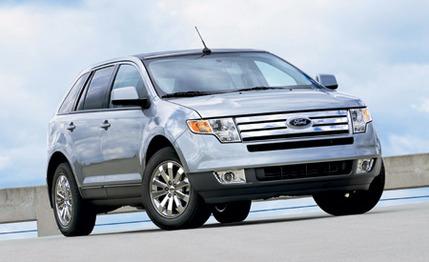 Road Test
Road Test
Like many companies, Ford is no stranger to dire economic straits or looking for signs of hope in a bleak future. But it will take more than hope to keep the corporate ship off the rocks. It will take cost-cutting, belt-tightening, and other measures that you could predict. But more important, it will take vehicles that capture the eyes, imagination, and disposable income of folks out there in consumerdom. Ford simply can't afford any more losers — or even ho-hums like the Five Hundred sedan and Freestyle SUV.
Against this ominous backdrop, here's the Ford Edge, a new crossover utility vehicle (CUV). Does it have the right stuff to help Ford steer clear of the shoals? Or is it just another face in a fast-growing crowd?
The facial issue is pertinent, because it's an element that gives the Edge some edge. The front fascia, with its Fusion-esque bright three-bar grille, may not be quite as eye grabbing as the jack-o'-lantern grin on the Nissan Murano, but it's distinctive, as well as more attractive. And it makes the Toyota Highlander look like a wallflower.
The Murano and the Highlander are not chance comparators here. They're the vehicles the Edge development team seeks to compete with. The Fusion allusion isn't random, either. Elements of the sedan's architecture were baked into the CUV's unibody, although of course the Edge is taller, wider, and substantially heavier: our loaded SEL Plus test vehicle scaled in at 4528 pounds. Whoa, Nellie!
As noted, the Edge is a unibody design, universal among today's passenger cars and de rigueur for crossovers. Unibodies — the car's body, floor pan, and chassis form a single structure — can provide higher structural rigidity, lower curb weights, and dynamics that are more like passenger cars than the trucklike responses of body-on-frame SUVs. Does this sound familiar? Sure. We've been hearing the same carlike drivability mantra since Chrysler's first minivan back in 1984.
Please. The idea that a vehicle weighing more than two tons, with eight inches of ground clearance and a 67.2-inch roofline, can prance around like a mid-size sedan is like expecting a bear to learn tap dance. But if you modify your dynamic expectations, the Edge delivers responses that are quite respectable for a vehicle in this size class.
Hardware: As noted, there's front-wheel-drive Mazda 6/Ford Fusion skeletal heritage in this vehicle's foundation, albeit expanded for a much different task. The wheelbase, for example, measures 111.2 inches, although overall length — 185.7 inches — is shorter than the Fusion by 4.5 inches. On the other hand, at 75.8 inches wide, the Edge is wider than the Freestyle.
Although the wheelbase is one of the longest in this mid-size class, the chassis is exceptionally stiff. High chassis rigidity and a long wheelbase equal good ride quality, another edge for the Edge. With subframe-mounted front struts, a multilink rear, and anti-roll bars fore-and-aft, the Edge smoothes lumpy pavement — as well as dirt-road nastiness — without feeling squishy. Severe washboard stretches can provoke an impromptu dance step or two, but for the most part, the Edge is about as composed and responsive as 2.3 tons of tallish SUV can be.
Our test vehicle's composure was enhanced by an all-wheel-drive system capable of anticipating traction loss and transferring torque rearward as needed, up to 100 percent, according to Ford. Standard on all Edges is AdvanceTrac with RSC, unique in its use of a gyroscopic sensor to monitor both vehicle yaw and roll motions. When either or both become excessive in the judgment of a brain chip somewhere in there, the system uses brake and/or throttle intervention to restore equilibrium.
Although not particularly quick at 3.1 turns lock to lock, the rack-and-pinion power steering delivers a gratifying level of feedback and accuracy. There's enough roll stiffness to keep the horizon more or less level, and there's enough motor to move all this mass through the landscape with a fair degree of urgency.
The 3.5-liter V-6 bears the familiar Duratec imprint, but it's all-new, according to Ford, and beyond its general layout — 60-degree cylinder banks, twin cams, four valves per cylinder — it shares nothing with previous Duratecs. This is a good thing, because the Freestyle's 3.0-liter Duratec V-6 is, to be kind, anemic: 203 horsepower, 207 pound-feet of torque. The new V-6 raises the ante to 265 horsepower and 250 pound-feet, and mated with a new six-speed automatic it musters enough punch to hurry the Edge to 60 mph in 7.6 seconds and through the quarter-mile in 16.0 seconds at 87 mph.
Ford tells us the new engine's design makes allowance for eventual increases in both bore and stroke. The engineers also plan to install direct injection at some point, a refinement that was tabled in initial development for reasons of cost. It's worth noting that this engine will also be available in the Ford Five Hundred and Freestyle, which should reduce their ennui factor, and also in the revised — and substantially improved — Lincoln MKZ sedan, as well as the MKX, Lincoln's version of the Edge.